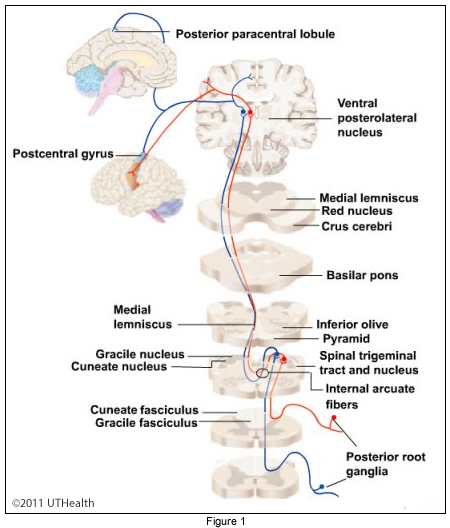Lab 6 (ƒ9) Descending Pathways to the Spinal Cord
NOTE - 17 Sep 21
The labs have been re-numbered. The former lab number is referenced in parentheses (ƒ xx), above.
| Old Lab Number | New Lab Number |
| 1 | 1 |
| 2 | 10 |
| 3 | 4 |
| 4 | 2 |
| 5 | 3 |
| 6 | 7 |
| 7 | 8 |
| 8 | 5 |
| 9 | 6 |
| 10 | 9 |
| 11 | 11 |
Purpose:
 As you learned in Lab exercise 8, the basal ganglia, cerebellum, and thalamus play a major role in motor function. However, of these motor structures, only the deep cerebellar nuclei (fastigial and interposed nuclei) send axons directly to spinal cord. The remainder of these motor structures exert their primary influence on the cerebral cortex and on certain brainstem nuclei which, in turn, send their axons to interneurons or to motor neurons in the spinal cord and brainstem.
As you learned in Lab exercise 8, the basal ganglia, cerebellum, and thalamus play a major role in motor function. However, of these motor structures, only the deep cerebellar nuclei (fastigial and interposed nuclei) send axons directly to spinal cord. The remainder of these motor structures exert their primary influence on the cerebral cortex and on certain brainstem nuclei which, in turn, send their axons to interneurons or to motor neurons in the spinal cord and brainstem.
You will trace fiber tracts in brain and spinal cord sections stained for myelin. Often the tracts travel in close proximity and cannot be distinguished from one another or from other nearby tracts. DO NOT PANIC if you cannot find the EXACT location of the tract in question. Learn its position relative to other more easily recognized structures.
In this lab we will consider the descending pathways that exert a more direct influence on the activity of spinal cord motor neurons.
Objectives:
At the end of this exercise, you should be able to:
- Identify the major descending tracts of the spinal cord.
- Identify the locations of the cells of origin (cortical or brainstem nuclei) of the descending tracts.
- Describe the important connections of the cells of origin of these descending tracts.
- Describe the influence of these descending tracts on motor activity.

